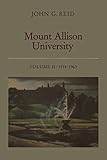Mount Allison University, Volume II : 1914-1963 / John Reid.
Material type: TextSeries: HeritagePublisher: Toronto : University of Toronto Press, [1984]Copyright date: ©1984Description: 1 online resource (546 p.)Content type:
TextSeries: HeritagePublisher: Toronto : University of Toronto Press, [1984]Copyright date: ©1984Description: 1 online resource (546 p.)Content type: - 9781487581343
- 9781487580445
- 378.715/23 23
- LE3.M92
- online - DeGruyter
| Item type | Current library | Call number | URL | Status | Notes | Barcode | |
|---|---|---|---|---|---|---|---|
 eBook
eBook
|
Biblioteca "Angelicum" Pont. Univ. S.Tommaso d'Aquino Nuvola online | online - DeGruyter (Browse shelf(Opens below)) | Online access | Not for loan (Accesso limitato) | Accesso per gli utenti autorizzati / Access for authorized users | (dgr)9781487580445 |
Browsing Biblioteca "Angelicum" Pont. Univ. S.Tommaso d'Aquino shelves, Shelving location: Nuvola online Close shelf browser (Hides shelf browser)

|

|

|

|

|

|

|
||
| online - DeGruyter Radical Mandarin : The Memoirs of Escott Reid / | online - DeGruyter Editing Nineteenth-Century Texts / | online - DeGruyter New Forms of Work Organization : The Challenge for North American Unions / | online - DeGruyter Mount Allison University, Volume II : 1914-1963 / | online - DeGruyter The Lear World : A study of King Lear in its dramatic context / | online - DeGruyter Old Man Savarin Stories : Tales of Canada and Canadians / | online - DeGruyter The Man from Halifax : Sir John Thompson, Prime Minister / |
restricted access online access with authorization star
http://purl.org/coar/access_right/c_16ec
This two-volume work examines the history of Mount Allison University and its antecedent secondary schools from the earliest years to 1963. Mount Allison's evolution is considered not only for its own internal dynamics but also in the context of the social, economic, and intellectual history of Canada's Maritime Provinces. Volume II covers the period starting with the outbreak of the First World War. At Mount Allison, as at other Canadian universities, both world wars profoundly affected institutional life. Mount Allison's development was also greatly influenced by the economic struggles of the inter-war years. The Maritime region, having experienced economic fluctuations following the decline of its seaborne trades in the late nineteenth century, emerged after the First World War as an area of persistent economic depression and social dislocation. Mount Allison was faced with the potentially conflicting demands of maintaining intellectual quality, through such means as attracting and retaining faculty members of high competence, while at the same time obeying the Christian obligation (influenced by the social gospel movement within the Methodist denomination and its successor, the United Church of Canada) to make education widely available at low cost. This dilemma persisted into the post-Second World War era at Mount Allison, when the brief but eventful period during which the campus was crowded by veteran students was followed by smaller enrolments and a search for financial support in order to maintain academic standards. Although the late 1950s and early 1960s brought fundamental changes in the form of new sources of funding, expansion of facilities, and changed attitudes among students and faculty, the central dynamic of Mount Allison's history remained one of struggle to reconcile responsibilities -- intellectual, moral, social -- which could not easily be reconciled.
Mode of access: Internet via World Wide Web.
In English.
Description based on online resource; title from PDF title page (publisher's Web site, viewed 01. Nov 2023)


